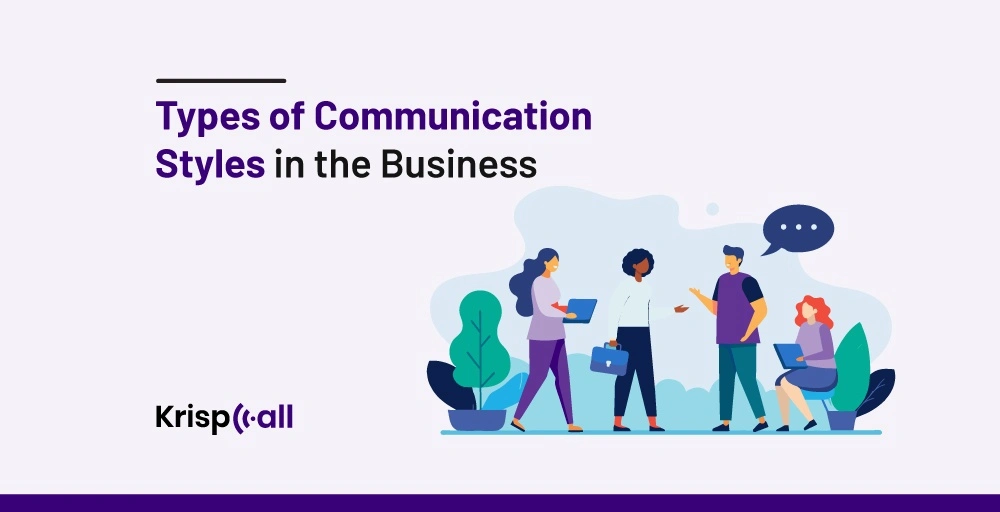Effective communication is a necessary skill in today’s business world. Whether negotiating a deal with potential clients, interacting with your coworkers🧑💼, or having a group meeting or discussion 📢, your communication style impacts the outcome.
Every business-associated person has their own style of communicating. One shouldn’t judge another based on their way of communication. Communication style is a necessary part of a business or workplace that can have both a positive and negative impact based on what type of style the employee, manager, and customer possesses.
It can be difficult to communicate if one doesn’t understand another’s communication style. So, In this blog, we have brought you a detailed guide on communication style, its importance in the business, types with their examples, and some of the best tips to improve it.
🔑KEY HIGHLIGHTS
- Communication styles are crucial for fostering better relationships, achieving positive outcomes, enhancing team collaboration, facilitating change in management, and improving customer service.
- There are five different communication styles mentioned and explained below: assertive, Aggressive, Passive, Manipulative, and Passive Aggressive.
- Assertive Communication emphasizes clear expression while totally respecting others’ opinion as well.
- Aggressive Communication involves dominating interactions and imposing opinions forcefully.
- Passive Communication involves difficulty in expressing thoughts directly and prioritizing others’ opinions over own.
- Manipulative Communication involves using deceptive tactics by controlling others’ emotions and achieve personal goals.
- Passive-aggressive communication involves showing indirect expressions of hostility, such as procrastination or stubbornness.
What is a Communication Style?
Communication style refers to expressing thoughts and feelings in a way that can be influenced by tone, language, facial expressions, behavior, and word choice. Fostering a better business relationship and achieving a positive outcome is essential. Every person can have a unique style of communication. But, one should make sure their communication style is making a positive impact on the business.
It’s necessary to know about various elements like written communication, interpersonal skills, cultural awareness, and verbal, and nonverbal communication, as understanding these involves adapting to various interactions within these elements.
Effective Communication styles are necessary for leaders and managers to maintain their goals and objectives in the future. It can be used for building a stronger client/customer relationship and building a brand with the help of public relations.
For Example, Let’s assume an IT company is having a team meeting to discuss a new project plan, where everyone brainstorms their ideas in a group. An assertive team member might speak up to give project ideas and viewpoints in his/her own opinion and invite every other team member to discuss his/her topic. Still, he/ she is also open to hearing other ideas and perspectives to promote better collaboration and open to alternative ideas.
Why are Communication Styles Important For Your Business?
Communication styles are important for business because they can help enhance team collaboration and facilitate change in management structure. Understanding and utilizing communication styles in business is necessary for managers and employees, as they positively impact work culture, business efficiency, and customer relationships. They are important because they help create good business communication.

Some of the major reasons why communication styles are important for the business are as follows:
1. Employee Retention & Engagement:
Communication styles are important for the business because they help in employee retention and engagement in the workplace. Fostering a feedback culture and recognition can boost employee morale and make them feel valued and included.
It helps build trust among employees, who can feel more committed to their coworkers, clients, managers, and organization. Clear Guidance with constructive feedback can help employees understand their career path.
2. Improve Customer Service and Relation:
Customer service agents or representatives can utilize different communication styles to improve customer service by solving and answering customers’ questions or queries. Consistent and clear communication with customers can help build trust and also help create a long-term customer relationship.
It helps build a business reputation and tailor communication aspects to fit customer preferences and needs, and enhance customer satisfaction and loyalty,
3. Proper Leadership & Management
The main reason why communication styles can be important for the business is because of an effective leadership and management. Leaders and Managers who implement communication styles can motivate their teams and inspire them to work properly.
Also, They can make a good decision-making process to ensure clear communication between the employees and customers, which can help build credibility and motivate employees to maintain higher performance.
4. Enhance Team Creativity and Innovation
The diverse team is required for effective communication strategies, which enhances a proper team’s creativity and innovation. It also helps team members clearly understand their main roles, responsibilities, and tasks.
Different communication styles can help a team get new, innovative, and creative ideas from each member. Understanding an appropriately diverse perspective can reduce misunderstandings and errors and resolve conflicts.
5. Build Trust & Loyalty
The final and last reason communication styles are important from a business perspective is that they can help set realistic expectations and foster trust, letting clients and customers feel valued and informed. Prompt and Timely responses can also satisfy customers with the service they are getting.
Communication with proper empathy and support among the employees helps strengthen loyalty and encourage a proper long-term relationship.
What are the Types of Communication Styles in the Business?
In every business, employees and managers have their own ways of communicating with their colleagues, coworkers, clients, or customers. Communication styles are like the backbone of a business. They are necessary for maintaining a positive work environment.
Some communication styles might cause someone to feel frustrated, guilty or have a negative impact. Below, we will discuss the business’s main communication styles with their definitions, tips, and examples.
1. Assertive Communication Style
Assertive communication is an effective style of communication in which an assertive communicator clearly expresses their thoughts, suggestions, opinions, and feelings while respecting others’ opinions. Showing empathy by considering the perspectives of others helps build a strong and positive relationship.
Assertive communicators maintain their self-esteem and confidence by advocating for their rights, which can lead to greater personal satisfaction. This is a common communication style in the business.
An example of Assertive Communication Style could be:
Suppose A customer is facing an issue. He/ She contacts a customer service agent to resolve the issue. The customer service agent acts like an assertive communicator in this case. A response example could be like:
“I am sorry for any inconvenience or issues you have encountered. Please mention your issues, and we could work together on this. I can give you step-by-step solutions for your issues. Also, Is there anything we need to work on?”
2. Aggressive Communication Style
Aggressive communication is a style in which an aggressive communicator dominates interactions by imposing their opinions on others and using forceful language to control the conversation fully.
Aggressive Communication includes sarcasm, verbal attacks, and sometimes insults. This type of communication style might occur when some employees are lazy or careless.
An example of Aggressive Communication Style could be:
Suppose Stuart and Adam are 2 IT Company employees working as QA analysts. Their main employer or boss is Calvin, who is very strict and wants the work done on time with no overdue dates. One day, Stuart and Adam are given tasks to identify technical issues and check bugs in at least 50 products, which should be done in 3 days. If unsuccessful, Then A response example of Calvin as an aggressive communicator could be like:
“I can’t believe you two guys can’t find technical issues and bugs on 50 products in just 3 days time. Are you guys lazy or what?”
3. Passive Communication Style
Passive Communication is another style of communication in which passive communicators are unable to express their thoughts, feelings, and opinions openly or directly. They prioritize other needs over their own, which might lead to frustration in the work environment.
Passive Communication includes conflict avoidance, indirectness, and resentment and can often cause misunderstanding or misinterpretation.
An example of a Passive Communication Style could be:
Suppose Flint and Stephen are employers and employees, respectively. Flint wants Stephen to give his best at work. As an employee, Stephen respects every decision and listens to his boss’ orders daily. Although working for 1 year, Stephen doesn’t get a salary hike. He, as a passive communicator doesn’t ask for it as well. So, he decides to work overtime to get an extra salary. But he’s not sure, if he will get that too. A response example from Stephen to Flint as a passive communicator could be like:
“Would It be okay if I work two extra 2 hours after my shift?”
4. Manipulative Communication Style
Manipulative Communication is a style in which manipulative communicators use deceptive tactics to control others’ emotions and manipulate them into achieving their goals while hiding their true intentions. Manipulative Speaking styles can create various types of problems inside a workplace.
Manipulative Communication includes emotional manipulation, gaslighting, and playing the victim card for sympathy. This style can lead to conflict and can damage work relationships.
An example of a Manipulative Communication Style could be:
Suppose Lucas and John are 2 employees working in a Trading Business Company. They both work well. But John is one of the manipulative communicators between the 2. John has an assignment due tomorrow, and he wants Lucas to complete his work. Lucas accepts that and does his work due to manipulative communication by John. A response example from John to Lucas as a manipulative communicator could be like:
“Hey Lucas, I need your urgent help right now. I need you to do my assignment right away. I have so many other tasks left. I hope you can understand. I’ll sure return a favor whenever you need help any other day. Thanks.”
5. Passive Aggressive Communication Style
Passive Passive-aggressive communication is a style in which passive-aggressive communicators use indirect expressions of hostility to accomplish requested tasks. This includes stubbornness, procrastination, or deliberate failure. They avoid direct confrontation but express their feelings and opinions in indirect ways.
Passive Aggressive Communication styles include sarcastic remarks, sullenness, silent treatment, backhanded compliments, etc.
An example of a passive-aggressive communication style could be:
Suppose Lisa and Mark are Managers and Employees respectively. Lisa assigns extra tasks to Mark, and Mark feels overburdened to do the work. A response example from Mark to Lisa as a passive-aggressive communicator could be like:
“Oh, Wow. Thanks, Boss for giving me another extra work. I’ll somehow focus on this between all the other urgent assignments. Isn’t it fun doing multi-tasking?”
5 Best Tips to Improve Your Communication Style
We have discussed the types of communication styles that occur in business. The one thing we are missing now is tips to improve each type of style. We have discussed various problems that occur in manipulative and aggressive communication. Let’s discuss the best tips for improving these styles in business.

1. Active Listening Skills
It is one of the best tips for improving one’s communication style. Active Listening involves fully responding and remembering what the other person is saying or talking about. It is not only about hearing; it’s about maintaining proper eye contact with the speaker and nodding to show a sense of engagement. It’s also about asking open-ended questions to encourage engagement and collaboration with the speaker. Active Listening is one of the best communication skills one should obtain in their business career.
2. Enhance Non-Verbal Communication
Nonverbal communication skills plays a vital role in expressive communication, as facial expressions, gestures, eye contact, and postures are major features that tell how another person receives the message. One major tip is to be aware of your body language and use appropriate facial expressions to convey your emotions to the audience.
3. Develop Emotional Intelligence
Emotional Intelligence is a process of expressing one’s emotions and understanding and managing the emotions of others. One major tip is to show empathy by acknowledging others’ feelings and managing emotions in stressful situations. Developing emotional intelligence is one of the communication skills to improve communication styles in the workplace.
4. Improve Conflict Resolution Skills
If you are an aggressive communicator, improving your conflict resolution skills is necessary. Approaching the conflict with a problem-solving mindset can be one major tip, and staying calm and composed and then addressing the issue without bringing up past problems can be another tip for aggressive communication. Conflict Resolution skills are important communication skills.
5. Develop Honesty & Transparency
This final and major tip is mainly for Manipulative Communicators. You should avoid using tactics that can mislead others and practice being clear about your main intentions and needs by sharing relevant information openly. Developing honesty and transparency are other communication skills that can improve your communication style in the business.
Conclusion
Communication styles are an important part of any business organization. One cannot focus well on one’s business without them. There are many more types of communication styles than the ones mentioned. Other communication styles are Listening, Collaborative, Analytical, and Expressive.
In the above article, we have mentioned the importance, types, and examples of communication styles and some of the best tips for improving them. By following these tips, businesses can cultivate respect and productivity, driving long-term success and growth.
FAQs
Which communication style can be important for resolving conflicts?
An assertive communication style can be crucial for resolving conflicts using empathy, collaboration, and problem-solving skills.
Which type of communication style can be risky for the business?
Aggressive and Passive-aggressive communication styles could be risky for the business, as both negatively impact work relationships through mistreatment and disrespect of the employees.
Why assertive communication style is considered the ideal communication style?
The assertive communication style is ideal because it fosters mutual respect and helps build trust and credibility among the team members.





